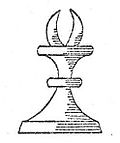Alfil
An alfil (or elephant) is a xiangqi piece and fairy chess piece that jumps two squares diagonally. In many chess variants, but not in xiangqi, it can leap over intermediate pieces.
Movement
The alfil jumps two squares diagonally, leaping over any intermediate piece.
History and nomenclature
The alfil is a very old piece, appearing in some very early chess variants, such as Tamerlane chess and shatranj. The elephant in xiangqi moves like an alfil, but has additional restrictions involving where it can move.
The piece was originally called an elephant, and two of its alternate names were hastīn and gāja, two Sanskrit words for elephant. It was probably one of the original chess pieces, appearing in chaturanga and shatranj. However, its original move is uncertain; two possibilities, excluding the current alfil move, are the dabbaba move (jumping two squares orthogonally) and the move of the silver general from shogi. The variant using the dabbaba move eventually died out, but the other variant spread to Burma and Siam, where it became the move for the equivalent pieces in the Burmese (sittuyin) and Thai (makruk) variants of chess. The silver general move was stated by Henry Davidson to resemble the four legs and trunk of an actual elephant. However, H. J. R. Murray in his History of Chess considered the two-square diagonal leap to be the original move, and reasoned that the main reason for the changes that made the alfil and ferz stronger in modern chess during the Renaissance (becoming the bishop and queen, respectively) were that these were originally the weakest pieces in the game (except the pawns). The alfil can only reach one eighth of the squares on the board, while the dabbaba can reach one quarter and the silver general can reach every square on the board.
When chess came to Persia from India, the Sanskrit name was translated to pil, and when chess came to the Muslims from Persia, the move had not changed, and then the name changed into Arabic to fil, the already existing cognate to pil which comes from the Akkadian language and ultimately from the Egyptian language. The name thus became fil and then alfil (prefixing the Arabic definite article, al). The names sometimes changed even more when chess eventually reached Europe, but eventually started to refer to the modern bishop rather than the alfil. Although alfil is still the name of the bishop in Spanish and some other European languages, its former name alfil began to be used in chess problems in English to refer exclusively to the original alfil (a (2,2)-leaper).
Value
The alfil by itself is not much more powerful than a pawn, but as an additional power to other pieces it is worth about half a knight. Eight alfils (each covering a different eighth of the chessboard) and a king can force checkmate on a bare king. Its value as a piece by itself is severely compromised by its being "thrice-colourbound", only being able to reach an eighth of the squares on the 8×8 chessboard; combining it with other pieces usually masks this weakness to some extent.
References
- Dickins, Anthony (1971) [Corrected repub. of 1969 2nd ed., The Q Press, Richmond, Surrey, England]. A Guide to Fairy Chess. New York: Dover Publications Inc. ISBN 0-486-22687-5.
External links
- The Alfil by Ralph Betza, The Chess Variant Pages
- Piececlopedia: Alfil by Fergus Duniho and Hans Bodlaender, The Chess Variant Pages


